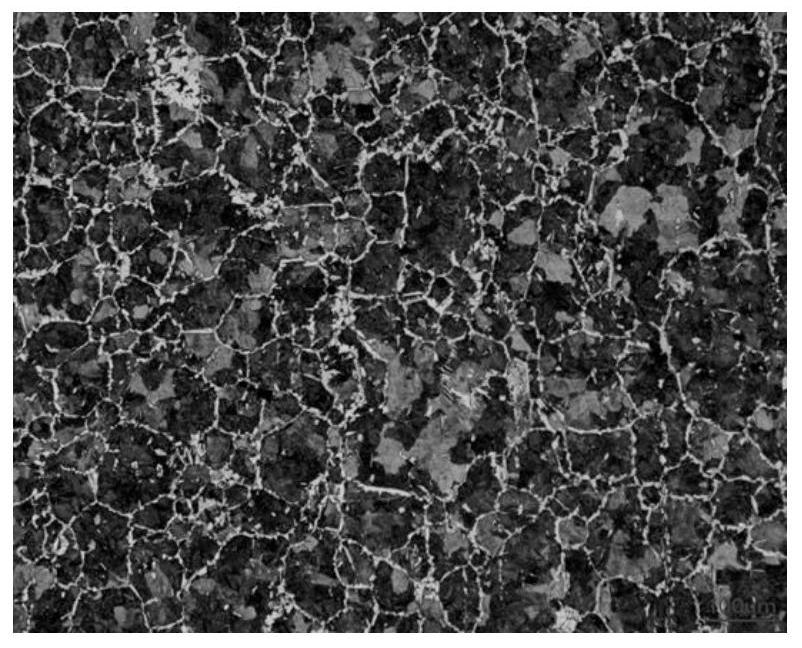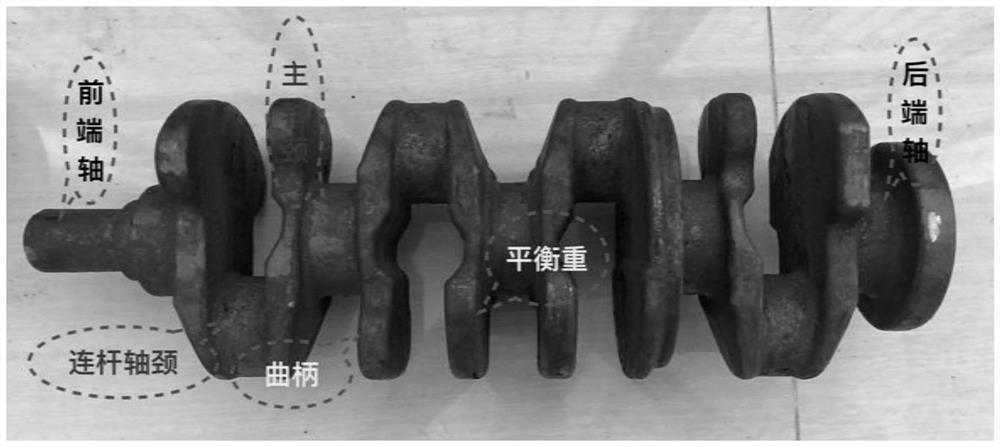Steel for non-quenched-and-tempered crankshaft of engine and preparation method of forging of steel
A non-tempering, engine technology, applied in the direction of manufacturing tools, temperature control, metal processing equipment, etc., to achieve the effect of reducing deformation resistance, large deformation, and refined grains
- Summary
- Abstract
- Description
- Claims
- Application Information
AI Technical Summary
Problems solved by technology
Method used
Image
Examples
Embodiment 1
[0040] A steel for non-quenched and tempered crankshafts of engines, containing chemical elements C: 0.38; Si: 0.57; Mn: 1.45; S: 0.055; Ni: 0.135; P: 0.022; Cr: 0.15; Mo: 0.046 ; Cu: 0.15; Ni: 0.137; V: 0.09; Al: 0.012; Ti: 0.010; N: 177ppm, the balance being Fe and impurities. Among them, the ratio of aluminum to nitrogen = 0.68, and the ratio of titanium to nitrogen = 0.56.
[0041] A method for preparing a forging of steel for an engine non-quenched and tempered crankshaft, comprising the following steps:
[0042] S1, smelting the above chemical elements into steel for non-quenched and tempered crankshafts of engines;
[0043] S2. Heat the engine non-quenched and tempered crankshaft steel to 1250°C; roll the material through the processes of starting rolling, water cooling, and finishing rolling. The starting rolling temperature is 1130°C, and the finishing rolling temperature is 1000°C. After rolling The diameter of the obtained bar is 90-100mm;
[0044] S3. Inductivel...
Embodiment 2
[0046] A steel for non-quenched and tempered crankshafts of engines, containing chemical elements C: 0.38; Si: 0.60; Mn: 1.46; S: 0.045; Ni: 0.147; P: 0.022; Cr: 0.14; Mo: 0.032 ; Cu: 0.17; Ni: 0.144; V: 0.08; Al: 0.010; Ti: 0.010; N: 166ppm, the balance being Fe and impurities. Wherein, the ratio of aluminum to nitrogen=0.60, and the ratio of titanium to nitrogen=0.60.
[0047] A method for preparing a forging of steel for an engine non-quenched and tempered crankshaft, comprising the following steps:
[0048] S1, smelting the above chemical elements into steel for non-quenched and tempered crankshafts of engines;
[0049] S2. Heat the engine non-quenched and tempered crankshaft steel to 1230°C; roll the material through the processes of starting rolling, water cooling, and finishing rolling. The starting rolling temperature is 1110°C, and the finishing rolling temperature is 980°C. After rolling The diameter of the obtained bar is 90-100 mm;
[0050] S3. Inductively hea...
Embodiment 3
[0052] A steel for non-quenched and tempered crankshafts of engines, containing chemical elements C: 0.39; Si: 0.65; Mn: 1.38; S: 0.056; Ni: 0.136; P: 0.022; Cr: 0.15; Mo: 0.025 ; Cu: 0.18; Ni: 0.137; V: 0.08; Al: 0.010; Ti: 0.008; N: 170ppm, the balance being Fe and impurities. Among them, the ratio of aluminum to nitrogen = 0.59, and the ratio of titanium to nitrogen = 0.47.
[0053] A method for preparing a forging of steel for an engine non-quenched and tempered crankshaft, comprising the following steps:
[0054] S1, smelting the above chemical elements into steel for non-quenched and tempered crankshafts of engines;
[0055] Such as figure 1 As shown in S2, heat the steel for non-quenched and tempered engine crankshafts to 1220°C; roll the material through the processes of starting rolling, water cooling, and finishing rolling. The starting rolling temperature is 1100°C, and the finishing rolling temperature is 970°C. The diameter of the bar obtained after the process...
PUM
| Property | Measurement | Unit |
|---|---|---|
| tensile strength | aaaaa | aaaaa |
| yield strength | aaaaa | aaaaa |
| hardness | aaaaa | aaaaa |
Abstract
Description
Claims
Application Information
 Login to View More
Login to View More - R&D
- Intellectual Property
- Life Sciences
- Materials
- Tech Scout
- Unparalleled Data Quality
- Higher Quality Content
- 60% Fewer Hallucinations
Browse by: Latest US Patents, China's latest patents, Technical Efficacy Thesaurus, Application Domain, Technology Topic, Popular Technical Reports.
© 2025 PatSnap. All rights reserved.Legal|Privacy policy|Modern Slavery Act Transparency Statement|Sitemap|About US| Contact US: help@patsnap.com



